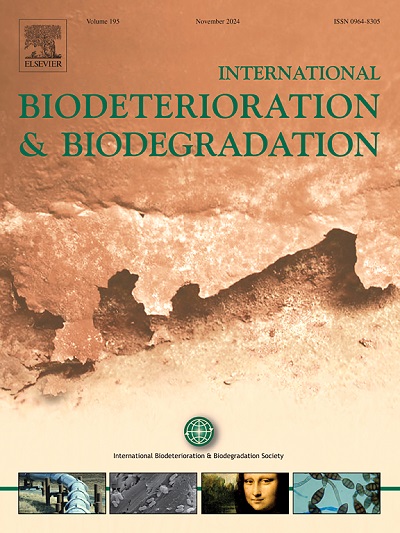Enhanced biodegradation of sulfamethazine in swine manure composting: Pathway elucidation, mechanism insights, and optimization of a novel Bacillus sp. strain
IF 4.1
2区 环境科学与生态学
Q2 BIOTECHNOLOGY & APPLIED MICROBIOLOGY
International Biodeterioration & Biodegradation
Pub Date : 2025-05-05
DOI:10.1016/j.ibiod.2025.106112
引用次数: 0
Abstract
Sulfamethazine (SMZ), a widely used sulfonamide antibiotic frequently detected in livestock waste streams, requires enhanced microbial degradation strategies to prevent its accumulation and associated environmental hazards. While several microbial strains with SMZ degradation capability have been isolated, comprehensive elucidation of metabolic pathways remains incomplete. This study identified Bacillus sp. strain DLY-11, exhibiting exceptional SMZ degradation performance, from thermally treated swine manure compost substrates. Under optimized parameters (5 % (v/v) bacterial inoculum, 59.7 °C operational temperature, pH 8.08 maintained with buffer system, and 0.4 g/L MgSO4 supplementation), the strain achieved 97.1 % elimination of 20 mg/L SMZ within 48-h incubation. Metabolic pathway analysis through detected intermediates revealed two distinct biodegradation mechanisms involving sulfonamide bond cleavage, oxidative hydroxylation, sulfur dioxide elimination, ring oxidation, amino group substitution, and glucuronic acid conjugation. These findings enhance understanding of sulfonamide antibiotic catabolism while offering a promising microbial resource for controlling veterinary antibiotic contamination in agro-industrial ecosystems.

猪粪堆肥中磺胺乙嗪的生物降解:一种新的芽孢杆菌菌株的途径阐明、机制研究和优化
磺胺乙嗪(SMZ)是一种广泛使用的磺胺类抗生素,经常在牲畜废物流中检测到,需要加强微生物降解策略,以防止其积累和相关的环境危害。虽然已经分离出几种具有SMZ降解能力的微生物菌株,但对其代谢途径的全面阐明仍不完整。本研究从热处理猪粪堆肥基质中鉴定出菌株DLY-11,表现出优异的SMZ降解性能。在最佳接种量为5% (v/v)、操作温度为59.7℃、缓冲液pH为8.08、MgSO4添加量为0.4 g/L的条件下,菌株在培养48 h内对20 mg/L SMZ的去除率达到97.1%。通过检测到的中间体代谢途径分析揭示了两种不同的生物降解机制,包括磺酰胺键裂解、氧化羟基化、二氧化硫消除、环氧化、氨基取代和葡萄糖醛酸偶联。这些发现增强了对磺胺类抗生素分解代谢的认识,同时为控制农工生态系统中的兽医抗生素污染提供了有前途的微生物资源。
本文章由计算机程序翻译,如有差异,请以英文原文为准。
求助全文
约1分钟内获得全文
求助全文
来源期刊
CiteScore
9.60
自引率
10.40%
发文量
107
审稿时长
21 days
期刊介绍:
International Biodeterioration and Biodegradation publishes original research papers and reviews on the biological causes of deterioration or degradation.

 求助内容:
求助内容: 应助结果提醒方式:
应助结果提醒方式:


